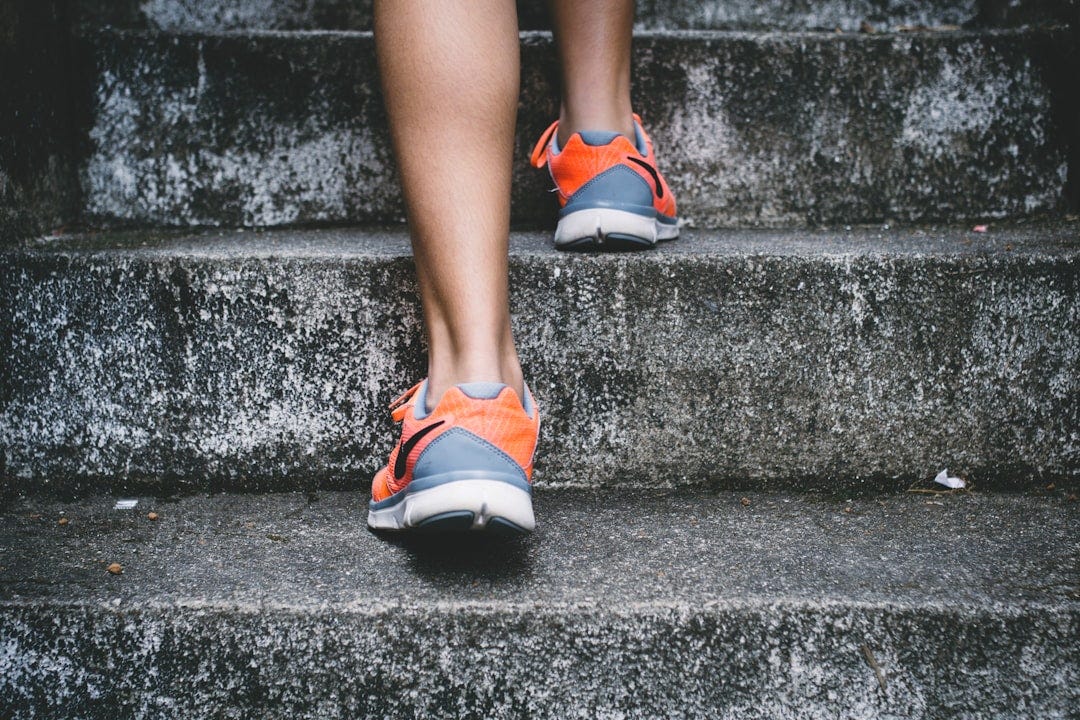Thanks to everyone who signed up for the 2-Week 2% Challenge. We've had thousands of signups and are getting great feedback.
Let's stay on the theme of being a 2-Percenter.
It's probably not shocking that people today move less than we did in the past. Our early ancestors’ lives forced them to be active. Anthropologists at Harvard told me that humans were “essentially professional athletes whose livelihood required (us) to be physically active.” They didn’t “work out” because they spent most of their waking hours doing necessary-to-not-die tasks that we today would classify as exercise. They spent their days digging, carrying, walking, and sometimes running, covering anywhere from 5 to 20 miles. It was a lot of work, but they did the bare minimum needed to survive.
It would be impossible to mimic the constant effort our ancestors faced. And I don’t think it’s even desirable. Having the option of being lazy is a blessing. Very few people who toil for their food actually want to.
But our health has suffered because of inactivity. Research shows that being sedentary now kills more people than obesity.
Luckily, the more sedentary we are, the bigger benefits we’ll see from adding movement back into our day. Consider this wild study finding: Older women who got 4,400 steps a day experienced a 50 percent less risk of dying during the research period compared to those who logged just 2,700 steps.
Enter being a 2-Percenter. Going to the gym is great. But it often leads us to see physical effort as a 30- or 60-minute thing we do at a gym—separate and distinct from our daily lives. Then we end up being inactive the rest of the day.
Whether you go to the gym or not, figuring out ways to sneak activity back into your days can be even more effective and sustainable. That's what the 2-Percent movement is all about: Accepting short-term discomfort for the sake of long-term growth. Accumulating little wins across the day that add up to big changes.
Here are a few ways to do just that:
Take the stairs
We all know we should do this—but we forget how powerful it can be. One study found that men who climbed 20 to 34 flights of stairs each week experienced 38 percent fewer strokes than those who climbed 10 or fewer flights a week.
Sit on a stool or on the floor
People who frequently sit without using a backrest have back and core muscles that are anywhere from 20 to 40 percent stronger—and this can help prevent and relieve back pain. If you watch TV or read every night or meditate every morning, try doing it cross-legged while keeping your torso vertical. It’s harder than it looks—but the discomfort in your legs and back and core suggests you have a relative weakness there. Fix it, and you’ll be better off. (Fun fact: I fixed a reader’s chronic back pain with this tip.) This phenomenon also explains why people in developing countries, who use fewer backrests, have lower rates of hip and back problems.
Take walking breaks, phone calls, and meetings
Beyond the calorie burn, people who walk to clear their minds perform better on creativity tests and report being more satisfied with their jobs. Walking allows your mind to wander to creative places. (Also remember that you can always call into a Zoom meeting from your phone and go for a walk. I do this often.)
Ruck while (insert task)
In preparing to spend a month in the Arctic for The Comfort Crisis, I knew I had to get used to carrying a heavy pack. So I’d do chores like cleaning, vacuuming, etc, while wearing a heavy ruck. I found it so beneficial that I’ve continued the practice. It’ll help you burn two or three times the calories and will also strengthen all your muscles without bulking you up.
Carry whenever you can
You’ll burn two or three times more calories than walking. Carrying is also one of the best ways to train your core. It can improve your performance in any physical activity.
Establish a “buy-in”
We all have a questionable habit or two we love. For example, binging Netflix or Instagram. Mine’s drinking diet soda (don’t ask me how many ounces I drink a day). Now, before I have a diet soda, I’ve established a “buy-in.” I do a quick bout of exercise before I pop the can. For example, a 60-second plank or 20 pushups. It adds up.
Speaking of adding up, here’s a full breakdown of the calorie burn of 10 minutes of the following activities:
Using a Standing Desk: 17
Walking Meeting: 40
Cleaning or Fixing Up Around The House: 47
Chopping or Stacking Wood: 109
Yard Work: 55
Carrying Light Groceries: 50
Cooking: 34
Dancing: 106 (a totally underrated form of stress relief)
Playing with Kids or a Dog: 79
Fidgeting While Sitting: 25
Walking Briskly (4.5MPH): 96
Climbing Stairs Briskly: 120
(These figures are for a 180-pound person and are drawn from the Compendium of Physical Activities)
Thanks for reading and I'll see you next week,
Michael
P.S., If you were forwarded this email, you can sign up here.
Sponsored by GORUCK
When I decided to accept sponsorships for this newsletter, GORUCK was a natural fit. Not only is the company's story included in The Comfort Crisis, but I've been using GORUCK's gear since the brand was founded. Seriously. They've been around ~12 years and I still regularly use a pack of theirs that is 11 years old. Most of their gear is made in the USA by former Special Forces soldiers. They make my favorite rucking setup: A Rucker and Ruck Plate.




